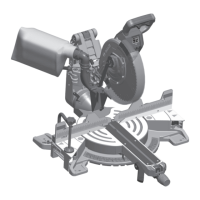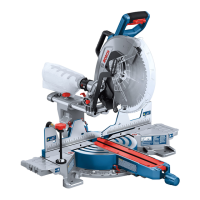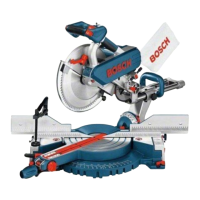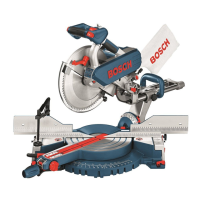43
Saw Operations
Slide Cuts
WHAT’S A SLIDE CUT?
• A “slide cut” is made with the head as-
sembly unlocked and able to move away
from the fence. This movement is sup-
ported and precisely controlled by the
axial glide system. The maximum cross-
cutting capacity is utilized by using this
method.
• A slide cut is best used for cross-cutting
workpieces wider than can be done with
a chop cut – pieces wider than 5-1/2"
(140mm) and up to a maximum width of
13-3/8" (340mm) across.
NEVER pull the saw to-
ward you during a cut.
The blade can suddenly climb up on top of
the workpiece and force itself toward you.
PREPARING FOR SLIDE CUT
1. Place the saw head in the UP position.
2. Disengage the mechanism lock lever
(item 27 – page 12) by pushing down on
the finger tab. With the head assembly
in the UP position, move it fully to the
front and back to check that axial glide
system moves smoothly.
3. Properly position your workpiece and
clamp it firmly to the table and/or fence.
Use a clamping position
that does not interfere
with operation. Before switching “ON”,
lower head assembly to make sure clamp
clears guard and head assembly.
Be aware of the path of
the saw blade. Make a
dry run with the saw Off by conducting a
simulated cutting cycle, and observe the
projected path of the saw blade. Keep
hands at least six (6) inches (152
mm)away from the projected path of the
saw blade.
MAKING A SLIDE CUT
1. Grasp the switch handle and pull the
saw head assembly (in UP position)
away from the fence – see Arrow 1 in Fig.
43.
2. Activate the switch, and then fully lower
the saw head assembly – on larger
pieces, this action may also start the cut
– see Arrow 2 in Fig. 43.
3. Push down and back so the saw head as-
sembly moves toward the fence and to
the full rear position until you complete
the cut. See Arrow 3 in Fig. 43. NOTE: If
high resistance is felt, do not apply ex-
cessive force – stop cutting, wait until
blade stops and investigate problem.
4. Hold the saw head down until the blade
comes to a complete stop. Return the
saw head to the UP position and remove
the workpiece.

